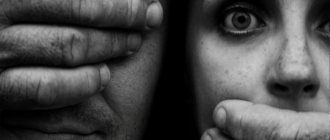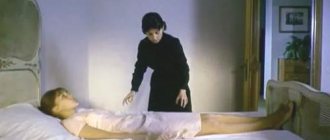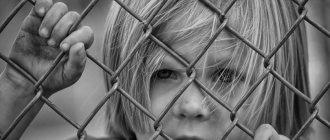"Pale" and "blue" ARP
Affective-respiratory attacks are divided into two types - “pale” and “blue”. “Pale” often manifests itself as a reaction to pain from an injection, blow, or fall. The pulse disappears, so it cannot be felt and counted. This type is very similar to fainting regarding the method of development. Children with paroxysms (breathing attacks) may subsequently suffer from fainting conditions.
But in most cases, children develop “blue” seizures. They are expressed by the child’s anger or dissatisfaction.
First aid, parental tactics for ARP
If your child has an attack of ARP when he once again threw a tantrum, it is important to take a couple of deep breaths and exhales, calming down yourself.
note
It is worth remembering that you yourself can hold your breath for a short time without harming your health, so do not panic yourself.
At the time of ARP, you can use various physical influences on the baby - blow in the face, tickle the ribs, lightly pat the cheeks. This promotes reflex restoration of the respiratory act.
If attacks have already happened before, it is worth intervening in the situation before the baby starts screaming and rolls. It is easier to stop the attack of rage and screaming before it reaches its peak. Kids can easily be distracted by getting them interested in something bright and new, a toy or entertainment. Even attempts to tickle or look at the phone often quickly distract and stop the hysteria in the bud.
If ARP has begun, and it drags on, the child becomes limp, the onset of convulsions is felt, you need to put the baby on a flat surface, turning his head to the side. This is necessary in case of vomiting, so that he does not aspirate the vomit into the respiratory tract. After the attack is over, you need to calm the child down and caress him, especially if he did not understand what happened. In many ways, the calmness of parents in such a situation helps a lot.
Causes
The main reasons may be refusal to fulfill his whim, if he does not get what he wants, or if he is simply not paid attention to when he wants it - the child begins to scream and cry. Deep breathing is interrupted from time to time, stopping on inspiration, the child becomes slightly cyanotic. In the best case, breathing will continue after a couple of seconds and the child will feel normal again. Externally, a “blue” attack is similar to a spasm of the muscles of the larynx, known as “laryngospasm”. In a more unfavorable case, it takes longer to manifest itself, as a result of which the child’s muscle tone decreases - in this case, he seems to “melt” in the mother’s arms; or vice versa - the muscles become very tense, causing it to arch. Most often they occur in hot-tempered, emotional and irritable children. They manifest themselves as hysterical attacks. A standard child's hysteria takes the form of protesting gestures - hitting the floor with their legs and arms, screaming, crying, showing dissatisfaction and rage.
From 3-4 years of age, a child with hysterical reactions or attacks of holding his breath differs from healthy children in his hysterics or problematic character. But there are ways to raise such children to prevent them from further developing a hysterical character as they grow up.
The basic principles of raising children with hysterical and respiratory-affective attacks are to prevent these attacks and educate the child to be restrained and control their emotions. Naturally, a surge of emotions is typical for all children and even adults. Adults, of course, know how to restrain their discontent. Children, for example, at the age of two are more open in this regard, since they have not yet been raised.
Respiratory-affective attacks
Authors : Bitterlich L. R.
Affective-respiratory attacks (attacks of breath holding) are the earliest manifestation of fainting or hysterical attacks. The word "affect" means a strong, poorly controlled emotion. “Respiratory” is something that has to do with the respiratory system. Attacks usually appear at the end of the first year of life and can continue until 2-3 years of age. Although holding their breath may seem deliberate, children usually do not do it on purpose. This is simply a reflex that occurs when a crying child forcefully exhales almost all the air from his lungs. At this moment he falls silent, his mouth is open, but not a single sound comes from it. Most often, these breath-holding episodes do not last more than 30-60 seconds and pass after the child catches his breath and starts screaming again.
Sometimes affective-respiratory attacks can be divided into 2 types - “blue” and “pale”.
“Pale” affective-respiratory attacks are most often a reaction to pain from a fall or an injection. When you try to feel and count the pulse during such an attack, it disappears for a few seconds. “Pale” affective-respiratory attacks, according to the mechanism of development, are close to fainting. Subsequently, some children with such attacks (paroxysms) develop fainting states.
However, most often affective-respiratory attacks develop according to the “blue” type. They are an expression of dissatisfaction, unfulfilled desire, anger. If you refuse to fulfill his demands, achieve what you want, or attract attention, the child begins to cry and scream. Intermittent deep breathing stops on inhalation, and slight cyanosis appears. In mild cases, breathing is restored within a few seconds and the child’s condition returns to normal. Such attacks are superficially similar to laryngospasm - a spasm of the muscles of the larynx. Sometimes the attack drags on somewhat, and either a sharp decrease in muscle tone develops - the child goes limp in the mother’s arms, or tonic muscle tension occurs and the child arches.
Affective-respiratory attacks are observed in children who are excitable, irritable, and capricious. They are a type of hysterical attack. More “ordinary” hysteria in young children is characterized by a primitive motor reaction of protest: when desires are not fulfilled, the child falls to the floor in order to achieve his goal: he randomly hits the floor with his arms and legs, screams, cries and demonstrates his indignation and rage in every possible way. This “motor storm” of protest reveals some features of hysterical attacks of older children.
After 3-4 years of age, a child with breath-holding or hysterical reactions may continue to have hysterical attacks or have other character problems. However, there are ways that can help you prevent the dreaded two-year-olds from turning into the dreaded twelve-year-olds.
Principles of proper education of a small child with respiratory-affective and hysterical attacks. Seizure prevention
Attacks of irritation are quite normal for other children, and indeed for people of all ages. We all experience bouts of irritation and rage. We never get rid of them completely. However, as adults, we try to be more restrained when expressing our dissatisfaction. Two-year-old children are more frank and direct. They are simply venting their rage.
Your role as parents of children with hysterical and respiratory-affective attacks is to teach children to control their rage, to help them master the ability to restrain themselves.
In the formation and maintenance of paroxysms, the incorrect attitude of parents towards the child and his reactions sometimes plays a certain role. If a child is protected in every possible way from the slightest upset - everything is allowed to him and all his demands are fulfilled - so long as the child does not get upset - then the consequences of such upbringing for the child’s character can ruin his entire future life. In addition, with such improper upbringing, children with attacks of breath holding may develop hysterical attacks.
Proper upbringing in all cases requires a unified attitude of all family members towards the child - so that he does not use family disagreements to satisfy all his desires. It is not advisable to overprotect your child. It is advisable to place the child in preschool institutions (nursery, kindergarten), where attacks usually do not recur. If the appearance of affective-respiratory attacks was a reaction to placement in a nursery or kindergarten, on the contrary, it is necessary to temporarily remove the child from the children's group and re-assign him there only after appropriate preparation with the help of an experienced pediatric neurologist.
The reluctance to follow the child’s lead does not exclude the use of some “flexible” psychological techniques to prevent attacks:
1. Anticipate and avoid flare-ups.
Children are more likely to burst into crying and screaming when they are tired, hungry or feel rushed. If you can anticipate such moments in advance, you will be able to circumvent them. You can, for example, avoid the hassle of waiting in line at the cashier at the grocery store by simply not shopping when your child is hungry. A child who gets irritated during the rush to get to nursery during the morning rush hour, when parents are also going to work and an older sibling is going to school, should get up half an hour earlier or, conversely, later - when the house is calmer . Recognize difficult moments in your child's life and you will be able to prevent attacks of irritation.
2. Switch from the stop command to the forward command.
Young children are more likely to respond to a parent's request to do something, called "go" commands, than to listen to a request to stop doing something. So if your child is screaming and crying, ask him to come to you instead of telling him to stop screaming. In this case, he will be more willing to fulfill the request.
3. Tell the child his emotional state.
A two-year-old child may be unable to verbalize (or simply acknowledge) his feelings of rage. In order for him to control his emotions, you should give them a specific name. Without making a judgment about his emotions, try to reflect the feelings the child is experiencing, for example: “Maybe you are angry because you didn’t get the cake.” Then make it clear to him that despite his feelings, there are certain limits to his behavior. Tell him, “Even though you are angry, you should not yell and scream in the store.” This will help the child understand that there are certain situations in which such behavior is not acceptable.
4. Tell your child the truth about consequences.
When talking to young children, it is often helpful to explain the consequences of their behavior. Explain everything very simply: “You have no control over your behavior and we will not allow it. If you continue, you will have to go to your room.”
Convulsions during respiratory-affective attacks
When a child’s consciousness is impaired during the most severe and prolonged affective-respiratory attacks, the attack may be accompanied by convulsions. The cramps are tonic - muscle tension is noted - the body seems to become stiff, sometimes arches. Less commonly, during respiratory-affective attacks, clonic convulsions are observed - in the form of twitching. Clonic convulsions are less common and are then usually observed against the background of tonic convulsions (tonic-clonic convulsions). Cramps may be accompanied by involuntary urination. After convulsions, breathing resumes.
In the presence of seizures, difficulties may arise in the differential diagnosis of respiratory-affective paroxysms with epileptic seizures. In addition, in a certain percentage of cases, children with affective-respiratory convulsions may subsequently develop epileptic paroxysms (attacks). Some neurological diseases can also cause such respiratory affective attacks. In connection with all these reasons, to clarify the nature of paroxysms and prescribe the correct treatment, every child with respiratory-affective attacks should be examined by an experienced pediatric neurologist.
What to do during a breath-holding attack
If you are one of those parents whose child holds their breath in a fit of rage, be sure to take a deep breath yourself and then remember this: Holding your breath almost never causes harm.
During an affective-respiratory attack, you can use any influence (blow on the child, pat the cheeks, tickle, etc.) to promote the reflex restoration of breathing.
Intervene early. It is much easier to stop a rage attack when it has just begun than when it is in full swing. Young children can often be distracted. Get them interested in something, say a toy or other form of entertainment. Even such a simple attempt as tickling sometimes brings results.
If the attack is prolonged and accompanied by prolonged general relaxation or convulsions, place the child on a flat surface and turn his head to the sides so that he does not suffocate if he vomits. Read in detail my recommendations “HOW TO HELP DURING AN ATTACK OF SEIZURES OR CHANGES IN CONSCIOUSNESS”
After an attack, reassure and reassure your child if he does not understand what happened. Reemphasize the need for good behavior. Don't back down just because you want to avoid repeat breath-holding episodes.
Treatment
There is no definite treatment in this case, especially since it is not fatal and after 3-4 years it all goes away. It is very important for parents to be informed so as not to be scared and not cause trouble for their child because of this. There are, of course, two directions for treatment - medicinal and non-medicinal. Moreover, the second method is the main one. The family needs to consult with a psychologist who will give valuable recommendations on raising the child, actions during the child’s attack and preventing its reoccurrence, as well as establishing mutual understanding in the family.
Only when parents cannot help the child themselves, it is necessary to use medications whose main function is to treat increased excitability and neuropathy. Treatment for a child should be selected only by a neurologist, and there is no need to listen to the advice of a pharmacist at the pharmacy. Medicines are selected individually for each child.
Why do seizures occur?
The leading causes are hereditary. There are children who are excitable from birth, and there are character traits of their parents that involuntarily provoke these attacks. The parents of such children also experienced bouts of “rolling down” in childhood . In children, affective-respiratory paroxysms can occur in response to the following situations and stimuli:
- adults ignoring the child’s demands;
- lack of parental attention;
- fright;
- excitation;
- fatigue;
- stress;
- overload with impressions;
- falls;
- injuries and burns;
- family scandal;
- communication with an unpleasant (from the child’s point of view) relative.
Adults must understand that the child reacts this way unconsciously, and not at all intentionally. This is a temporary and abnormal physiological reaction that is not under the child's control. The fact that a child has such a reaction is “to blame” for the characteristics of his nervous system, which cannot be changed. A child was born this way, early age is the beginning of all manifestations. This needs to be corrected by pedagogical measures in order to avoid character problems at an older age.
What does it look like?
Pediatricians conditionally divide affective-respiratory syndrome into 4 types. The classification is as follows:
- A simple option, or holding your breath at the end of the exhalation. Most often develops after a child’s dissatisfaction or trauma. Breathing is restored on its own, and blood oxygen saturation does not decrease.
- The “blue” option, which most often occurs after a pain reaction. After crying, a forced exhalation occurs, the mouth is open, the child does not make any sounds - “rolled”. Rolling of the eyes and cessation of breathing are visible. The baby first turns bright red, then turns blue, then goes limp, and sometimes loses consciousness. Some regain consciousness after regaining their breathing, while others immediately fall asleep for an hour or two. If you record an EEG (encephalography) during an attack, there are no changes in it.
- “White” type, in which the child almost does not cry, but turns sharply pale and immediately loses consciousness. Then comes sleep, after which there are no consequences. No seizure focus is detected on the EEG.
- Complicated - begins as one of the previous ones, but then paroxysms are added, similar to an epileptic attack, which can even be accompanied by urinary incontinence. However, subsequent examination does not reveal any changes. This condition can pose a danger to all tissues due to severe oxygen starvation, or brain hypoxia.
Such convulsions do not pose a threat to life, but consultation with a neurologist is required in order to distinguish them from more severe cases. Breathing stops for a period of time from several seconds to 7 minutes, and it is very difficult for parents to maintain composure. The average time to stop breathing is 60 seconds.
Mechanism of development and clinical picture
Seizures look scary, especially in infants. When a child stops breathing, the supply of oxygen to the body stops. If you hold your breath for a long time, muscle tone reflexively drops - the baby “goes limp.” This is a reaction to acute oxygen deficiency to which the brain is exposed. A protective inhibition occurs in the brain, its work is restructured to consume as little oxygen as possible. Eye rolling ensues, which greatly frightens parents.
With continued holding of breath, the muscles sharply increase tone, the child’s body tenses, arches, and clonic convulsions may occur - rhythmic twitching of the torso and limbs.
All this leads to the accumulation of carbon dioxide in the body - hypercapnia. This reflexively stops the spasm of the laryngeal muscles, and the baby takes a breath. Inhalation is usually done while crying, then the child breathes well and calmly.
In practice, seizures rarely occur. After apnea, the child usually immediately stops rolling; in some, breathing is restored after “going limp.”
Breathing and emotions
It’s not for nothing that the attack is called an affective-respiratory attack, or ARP for short. This is how a small child expresses his anger and dissatisfaction if something is done “not according to him.” This is a real affect, an emotional attack. Such a child is initially characterized by increased emotional excitability and capriciousness. If we leave character traits without attention, then at an older age the child gives real hysterical reactions if he is denied something: he falls to the floor, yells at the entire store or kindergarten, stomps his feet and calms down only when he gets what he wants. The reasons for this are twofold: on the one hand, the child has hereditary characteristics of the nervous system, on the other, the parents do not know how to treat him in such a way as to smooth out all the “corners” of his character.
How to treat this, will medications help?
It is important to take into account when planning therapy for a child that such attacks are the beginnings of future hysteria, and they usually arise as a variant of neuroses or neuropathies. Therefore, at least two main directions are important:
- family psychotherapy , which helps in correcting methods of raising a child, eliminating possible overprotection and conflicts between family members. We also need to normalize relationships in the family. It may be useful for the child to stay in a nursery or kindergarten, where the attacks pass without a trace.
- therapeutic correction , the use of drugs that eliminate the symptoms of neuropathy, strengthen the nervous system and sedatives. Calcium and magnesium supplements, herbal sedatives, and multivitamins are indicated. In more severe situations, vegetative correctors may be needed - phenibut, nootropil. If the attacks are daily and severe, anti-epileptic drugs can be prescribed in minimal doses (at night).
In children after 3 years, psychotherapy comes to the fore in treatment - fairy tale therapy, drawing and other age-related techniques. If a child has concomitant pathologies, they need treatment, sanitation of foci of chronic infection, courses of sedatives, and in highly excitable children, tranquilizers. Baths, hardening, regimen and proper nutrition are useful.
Alena Paretskaya, pediatrician, medical columnist
6, total, today
( 43 votes, average: 4.23 out of 5)
Panic attacks: symptoms and treatment
Causes and symptoms of schizophrenia







